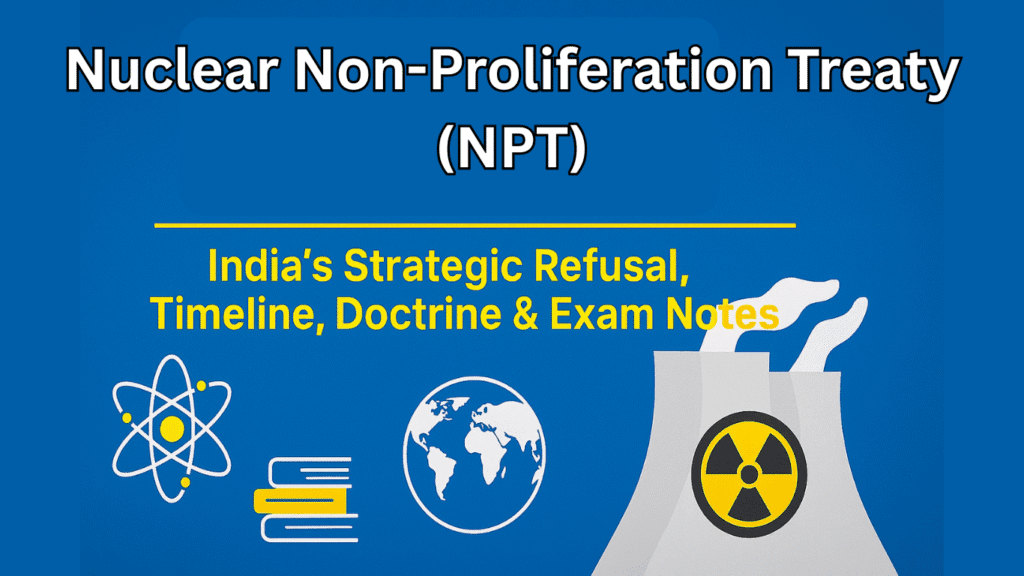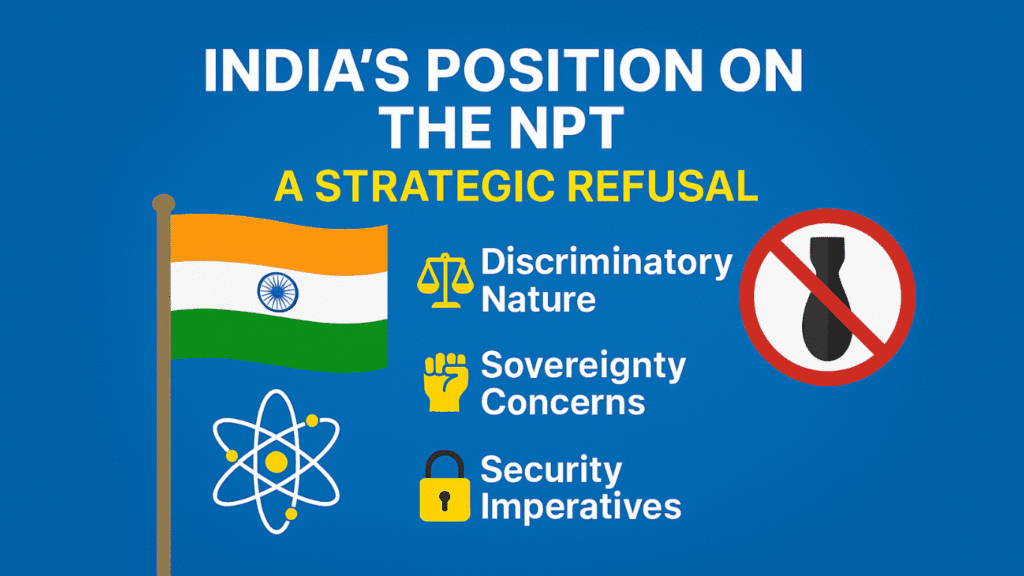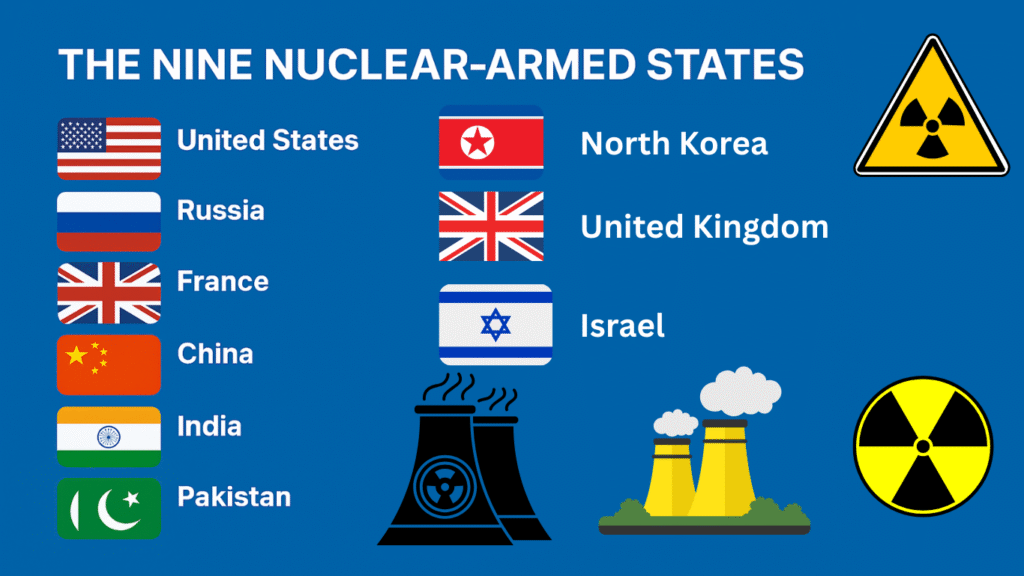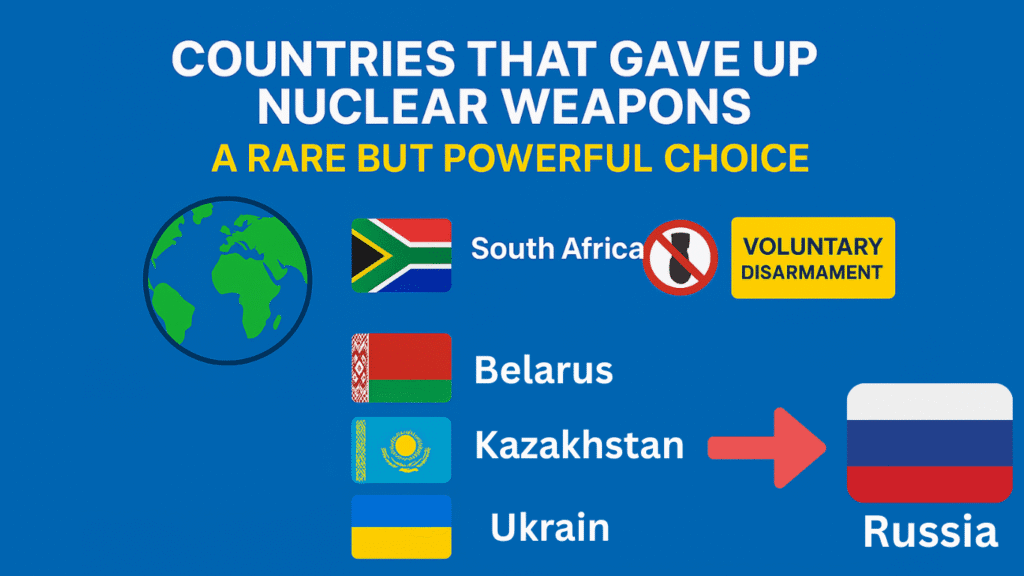
In the realm of global diplomacy, few treaties have shaped international security as profoundly as the Nuclear Non-Proliferation Treaty (NPT). For aspirants preparing for UPSC, Punjab PCS, Patwari, Excise Inspector, Senior Assistant, SSC CGL, and other prestigious exams, understanding the NPT is not just about scoring marks—it’s about grasping India’s strategic choices, its moral stance, and its place in the global nuclear order.
This article unpacks the NPT with an India-centric lens, weaving in emotional depth, historical context, and exam-ready facts. Whether you’re revising for prelims or crafting answers for mains, this guide will empower you with clarity, confidence, and cultural relevance.
🔗 While you’re here, don’t miss our deep-dive into Punjab (History & Culture) to understand how regional pride and strategic thinking have shaped India’s broader identity.
Table of Contents
🌍 What is the Nuclear Non-Proliferation Treaty (NPT)?
The Nuclear Non-Proliferation Treaty (NPT) is a landmark international agreement signed in 1968 and entered into force in 1970, aimed at preventing the spread of nuclear weapons and promoting peaceful uses of nuclear energy.
🔑 Key Objectives of the NPT:
- Non-Proliferation: Prevent non-nuclear weapon states from acquiring nuclear weapons.
- Disarmament: Commit nuclear weapon states to pursue disarmament.
- Peaceful Use of Nuclear Energy: Promote cooperation in nuclear energy for peaceful purposes.
📜 Structure of the Treaty:
The NPT is built on three pillars:
| Pillar | Description |
|---|---|
| Non-Proliferation | Only five countries (USA, UK, France, Russia, China) are recognized as nuclear weapon states. Others must not develop or acquire nuclear weapons. |
| Disarmament | All parties must work towards eliminating nuclear weapons. |
| Peaceful Use | Encourages sharing of nuclear technology for energy, medicine, and agriculture under IAEA safeguards. |
🧭 India’s Position on the NPT: A Strategic Refusal

India is not a signatory to the NPT. This decision is rooted in principled resistance and strategic autonomy.
🇮🇳 Why India Refused to Sign the NPT:
- Discriminatory Nature: The treaty gives special rights to a few countries that already have nuclear weapons and stops other countries from ever getting them. This creates an unfair system.
- Sovereignty Concerns: India believes in maintaining its strategic autonomy.
- Security Imperatives: Surrounded by nuclear powers like China and Pakistan, India cannot afford to rely solely on global promises.
🔗 For a deeper understanding of India’s diplomatic ethos, explore our Current Affairs & Strategic Articles that decode India’s foreign policy moves.
📚 Historical Timeline: India and the NPT
| Year | Event |
|---|---|
| 1968 | NPT opened for signature. India refused to sign. |
| 1974 | India conducted its first nuclear test—Smiling Buddha—at Pokhran. |
| 1998 | India conducted Operation Shakti (Pokhran-II), declaring itself a nuclear weapon state. |
| 2008 | India-US Civil Nuclear Agreement signed, despite India being outside the NPT. |
| 2010s | India continues to advocate for universal nuclear disarmament at UN forums. |
🔍 India’s Nuclear Doctrine: Peace with Preparedness
India’s nuclear policy is guided by its Nuclear Doctrine, which emphasizes:
- No First Use (NFU): India has a No First Use policy, which means it will only use nuclear weapons if another country attacks it with nuclear weapons first.
- Credible Minimum Deterrence: Maintain a sufficient arsenal to deter adversaries.
- Civilian Control: Nuclear command is under democratic civilian leadership.
🌐 Global Reactions to India’s Nuclear Status
Despite not signing the NPT, India has earned global respect for its responsible nuclear behavior.
✅ Positive Developments:
- Nuclear Suppliers Group Waiver (2008): India got access to nuclear technology despite being outside the NPT.
- IAEA Safeguards: India voluntarily placed civilian reactors under international inspection.
- Strategic Partnerships: India has built peaceful nuclear partnerships with countries like France, Russia, the United States, and Japan through various agreements focused on energy and technology.
❌ Challenges:
- NSG Membership Blocked: China opposes India’s entry into the Nuclear Suppliers Group.
- Pressure from NPT Advocates: Some countries still urge India to join the NPT.
🧪 Peaceful Uses of Nuclear Energy in India
India has harnessed nuclear energy for development, not destruction.
⚛️ Key Applications:
- Electricity Generation: Nuclear power plants like Tarapur, Kudankulam, and Kakrapar.
- Medicine: Cancer treatment using radiation therapy.
- Agriculture: Radiation-induced mutation for better crop varieties.
- Water Purification: Nuclear desalination plants.
- Disaster Management: Nuclear sensors and isotope tracers help monitor groundwater movement and predict seismic activity.
- Food Preservation: Radiation is used to sterilize spices, grains, and packaged foods—extending shelf life and reducing microbial load.
- Space Technology: Radioisotope thermoelectric generators (RTGs) are explored for deep-space missions and satellite power systems.
🔗 Want to boost your vocabulary for these topics? Visit our English Grammar & Vocabulary Section for aspirant-friendly word lists and usage tips.
🏛️ Institutions Governing Nuclear Energy in India
| Institution | Role |
|---|---|
| Department of Atomic Energy (DAE) | Oversees nuclear research and development. |
| Atomic Energy Regulatory Board (AERB) | Ensures safety standards in nuclear facilities. |
| Bhabha Atomic Research Centre (BARC) | Premier nuclear research institute. |
| Nuclear Power Corporation of India Ltd (NPCIL) | Operates nuclear power plants. |
🧭 Emotional Angle: India’s Moral Compass in a Nuclear World
India’s nuclear path reflects not just power and technology, but a deep commitment to dignity, self-control, and global responsibility. While some nations raced to stockpile weapons, India chose wisdom over warfare, peace over provocation.
For aspirants, this is a lesson in ethical leadership. India’s decision to stay out of the NPT isn’t an act of rebellion—it’s a principled stand for global nuclear equality. It’s a reminder that true strength lies in restraint, and that global justice must be inclusive.
🔗 Curious how these values echo in Punjab’s legacy? Dive into our Punjab (History & Culture) article to explore the region’s rich tradition of valor and diplomacy.
📊 India vs NPT Signatories: A Comparative Snapshot
| Country | NPT Status | Nuclear Tests | Doctrine | NSG Member |
|---|---|---|---|---|
| India | Not a signatory | Yes (1974, 1998) | No First Use | No |
| USA | Signatory | Yes | First Use Possible | Yes |
| China | Signatory | Yes | No First Use | Yes |
| Pakistan | Not a signatory | Yes | First Use Possible | No |
🌐 Who Actually Has Nuclear Weapons? The Real Power Map
While the Nuclear Non-Proliferation Treaty (NPT) aims to limit the spread of nuclear weapons, the reality is more complex. As of today, only nine sovereign nations possess nuclear arms—each with its own strategic rationale and historical journey.
🧨 The Nine Nuclear-Armed States:

| Country | NPT Status | Notes |
|---|---|---|
| 🇺🇸 United States | Signatory | The United States was the first country to develop nuclear weapons in 1945, during the Second World War. |
| 🇷🇺 Russia | Signatory | Largest nuclear arsenal in the world |
| 🇬🇧 United Kingdom | Signatory | Maintains a submarine-based deterrent |
| 🇫🇷 France | Signatory | Independent nuclear force, not under NATO command |
| 🇨🇳 China | Signatory | Follows a declared No First Use policy |
| 🇮🇳 India | Not a signatory | Strategic autonomy; No First Use doctrine |
| 🇵🇰 Pakistan | Not a signatory | Maintains First Use option against India |
| 🇰🇵 North Korea | Signed NPT in 1985, withdrew in 2003 | Carried out several nuclear trials after pulling out. |
| 🇮🇱 Israel | Never formally acknowledged | Believed to possess nuclear weapons; maintains deliberate ambiguity |
🔗 For aspirants curious about how India’s nuclear stance compares globally, check out our Current Affairs & Strategic Articles for deeper insights.
🕊️ Countries That Gave Up Nuclear Weapons: A Rare but Powerful Choice

Not every country that developed nuclear weapons chose to keep them. Some made the extraordinary decision to disarm, setting a moral precedent in global diplomacy.
🌍 Former Nuclear States:
- 🇿🇦 South Africa: Secretly developed nuclear weapons during apartheid but voluntarily dismantled its arsenal in the early 1990s. Joined the NPT as a non-nuclear state in 1991, becoming the first and only country to disarm voluntarily.
- 🇧🇾 Belarus, 🇰🇿 Kazakhstan, 🇺🇦 Ukraine: After the Soviet Union collapsed, these newly independent republics inherited nuclear weapons. By 1996, all transferred their arsenals to Russia and joined the NPT as non-nuclear states.
🔗 Want to express these stories in Punjabi? Visit our Punjabi Grammar & Translation Guide to make global topics locally relatable.
🧠 Practice Makes Perfect: Previous Year Questions
To solidify your understanding, practice with real exam questions.
🔗 Access our curated Previous Year Question Papers for PCS, Patwari, UPSC, and SSC to test your grasp on nuclear treaties and strategic affairs.
🧭 What Aspirants Should Take Away
The Nuclear Non-Proliferation Treaty (NPT) is more than a document—it’s a mirror reflecting global power dynamics. For India, it’s a challenge to balance security, sovereignty, and morality.
For you, the aspirant, it’s a golden opportunity to understand how India navigates global pressure with dignity, how it uses nuclear energy to uplift lives, and how it stands tall in a world of unequal treaties.
So next time you see “NPT” in your syllabus, don’t just memorize it—feel it. Understand the emotions, ethics, and strategy behind India’s nuclear journey. That’s what will set you apart in your exam—and in your understanding of the world.
